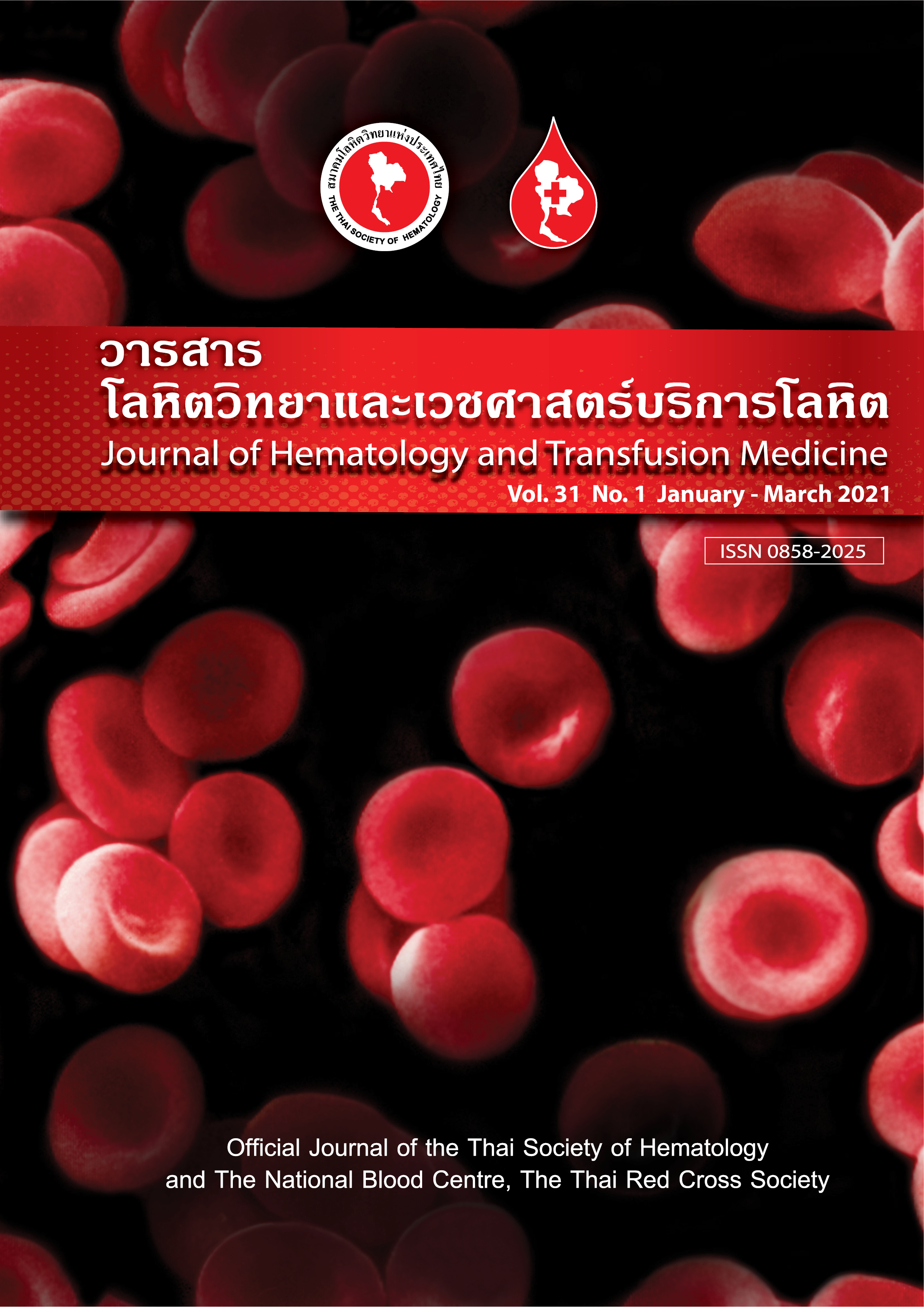Blood transfusion requirements for hematopoietic stem cell transplant patients in Songklanagarind Hospital
คำสำคัญ:
การปลูกถ่ายเซลล์ต้นกำเนิดเม็ดโลหิต, ส่วนประกอบของโลหิต, ปริมาณของเซลล์ต้นกำเนิดเม็ดโลหิตบทคัดย่อ
บทคัดย่อ
บทนำ ผู้ป่วยที่ปลูกถ่ายเซลล์ต้นกำเนิดเม็ดโลหิต (hematopoietic stem cell transplantation; HSCT) ทั้ง autologous HSCT (auto-HSCT) และ allogeneic HSCT (allo-HSCT) ต้องใช้ leukocyte depleted packed red cells (LDPRC) และ leukocyte depleted single donor platelet (LDSDP) อย่างต่อเนื่อง ทำให้งานบริการโลหิตต้องสำรองโลหิตให้เพียงพอ วัตถุประสงค์ เพื่อศึกษาความต้องการใช้ LDPRC และ LDSDP ของผู้ป่วย HSCT และศึกษาความสัมพันธ์ของปริมาณเซลล์ต้นกำเนิดเม็ดโลหิต (CD34+ cell dose) กับการใช้ LDPRC และ LDSDP วัสดุและวิธีการ ศึกษาข้อมูลการใช้ LDPRC และ LDSDP ของผู้ป่วย HSCT ในโรงพยาบาลสงขลานครินทร์ ตั้งแต่เดือนกุมภาพันธ์ พ.ศ. 2557 ถึงเดือนมิถุนายน พ.ศ. 2563 และศึกษาความสัมพันธ์ของ CD34+ cell dose กับการใช้ LDPRC และ LDSDP ผลการศึกษา ในผู้ป่วย 83 ราย พบปริมาณการใช้ LDPRC และ LDSDP ของกลุ่ม auto-HSCT เป็น 3.2±3.2 ยูนิต และ 5.5±5.1 ยูนิต ตามลำดับ กลุ่ม allo-HSCT เป็น 4.4±3.4 ยูนิต และ10.8±7.6 ยูนิต ตามลำดับ ซึ่งการใช้ LDPRC ไม่แตกต่างกัน (p = 0.12) แต่การใช้ LDSDP แตกต่างกันอย่างมีนัยสำคัญทางสถิติ (p < 0.05) ปริมาณ CD34+ cell dose ที่ใช้ในกลุ่ม auto-HSCT สูงกว่าและวันนอนโรงพยาบาลน้อยกว่ากลุ่ม allo-HSCT อย่างมีนัยสำคัญทางสถิติ (p < 0.05) ไม่พบความสัมพันธ์ระหว่าง CD34+ cell dose กับการใช้ LDPRC และ LDSDP สรุป ข้อมูลจากการศึกษานี้ช่วยทำนายและวางแผนการสำรอง LDPRC และ LDSDP ให้เพียงพอกับผู้ป่วยในช่วงเวลาที่รับการรักษาด้วย HSCT ให้เหมาะสม
Abstract:
Introduction: Hematopoietic stem cell transplantation (HSCT) is a potentially curative treatment for hematologic diseases. Most patients undergoing autologous HSCT (auto-HSCT) and allogeneic HSCT (allo-HSCT) require leukocyte depleted packed red cells (LDPRC) and leukocyte depleted single donor platelet (LDSDP) support. The rising number of HSCT performed has impacted transfusion services on inventory management. Objective: To study the LDPRC and LDSDP transfusion requirements of patients undergoing HSCT, and the correlation between CD34+ cell dose and blood utilization. Materials and Methods: A retrospective study analyzing LDPRC and LDSDP transfusion data on HSCT patients in Songklanagarind Hospital from February 2012 to June 2020 was reviewed. Correlation between CD34+ cell dose infusions and the number of units was also studied. Results: LDPRC and LDSDP requirement for 52 auto-HSCT patients were: 3.2±10.4 units and 5.5±26.2 units, respectively, and for 31 allo-HSCT patients were: 4.4±11.4 units and 10.8±57.7 units, respectively. We found no significant difference between each patient category for LDPRC utilization (p = 0.12); however, the LDSDP requirement was significant (p < 0.05). CD34+ cell dose infusion for the auto-HSCT group was significantly higher than each other, and the average time of hospitalization for auto-HSCT was significantly low (p < 0.05). No significant correlation between CD34+ cell dose infusion and LDPRC and LDSDP transfusion was observed for both of HSCT. Conclusion: Our data may support transfusion medicine staff in the prediction of transfusion requirements in HSCT. The average number of LDPRC and LDSDP required for each group and time interval can also be used to plan for blood inventory management.
Downloads
เอกสารอ้างอิง
Elemary M, Seghatchian J, Stakiw J, Bosch M, Sabry W, Goubran H. Transfusion challenges in hematology oncology and hematopoietic stem cell transplant - literature review and local experience. Transfus Apher Sci. 2017;56:317-21.
Xenocaostas Ax, Yee A, Wong CJ, Sutton DM, Lipton JH, Thomas L, et al. RBC transfusion requirements after allogeneic marrow transplantation: impact of the before-transplant Hb level on transfusion and early survival. Transfusion. 2003;43:373-81.
Khaddour K, Hana CK, Mewawalla P. Hematopoietic Stem Cell Transplantation. [Updated 2020 Jun 28]. In: StatPearls [Internet]. Treasure Island (FL): StatPearls Publishing; 2020 Jan-. Available from: https://www.ncbi.nlm.nih.gov/books/NBK536951/
Sureda A, Bader P, Cesaro S, Dreger P, Duarte RF, Dufour C, et al. Indications for allo- and auto-SCT for haematological diseases, solid tumors and immune disorders: Current practice in Europe, 2015. Bone Marrow Transplant. 2015;50:1037-56.
Wahid SF. Indications and outcomes of reduced-toxicity hematopoietic stem cell transplantation in adult patients with hematological malignancies. Int J Hematol. 2013;97:581-98.
Gajewski JL, Johnson VV, Sandler SG, Sayegh A, Klumpp T. A review of transfusion practice before, during, and after hematopoietic progenitor cell transplantation. Blood. 2007;112:3036-47.
Griffith LM, Vanraden M, Barret AJ, Childs RW, Fowler DH, Kang EM, et al. Transfusion support for matched sibling allogeneic hematopoietic stem cell transplantation (1993-2010): factors that predict intensity and time to transfusion independence. Transfusion. 2019;59:303-15.
Martin P. Documentation of engraftment and characterization of chimerism after hematopoietic cell transplantation. In: Negrin RS, Antin JH, Appelbaum FR, Forman SJ, editors. Thomas’ hematopoietic cell transplantation. 5th ed. Chichester: Wiley Blackwell; 2016. p. 272-80.
Olsson RF, Logan BR, Chaudhury S, Zhu X, Akpek G, Bolwell BJ, et al. Primary graft failure after myeloablative allogeneic hematopoietic cell transplantation for hematologic malignancies. Leukemia. 2015;29:1754-62.
Solves P, Sanz J, Gomez I, Puerta R, Arnao M, Montoro J, et al. Comparison of transfusion requirements in adult patients undergoing Haploidentical or single-unit umbilical cord blood stem cell transplantation. Eur J Haematol. 2019;103:172-7.
Tomac G, Bojanic I, Mazic S, Vidovic I, Raos M, Cepulic BG, et al. Haemolysis, pure red cell aplasia and red cell antibody formation associated with major and bidirectional ABO incompatible haematopoietic stem cell transplantation. Blood Transfus. 2018;16:397-404.
Chusri W, Somkitsiri S, Suntornopas B, Nathalang O. An Approach to Blood Utilization in Elective Surgery at BMA General Hospital. J Hematol Transfus Med. 2018;28:17-23.
Datta SS, Basu S, Chandy M. An analysis of transfusion support in haematopoietic stem cell transplantation - report from a centre in India. Transfus Apher Sci. 2015;53:373-7.
Erker CG, Steins MB, Fischer RJ, Kienast J, Berdel WE, Sibrowski W, et al. The influence of blood group differences in allogeneic hematopoietic peripheral blood progenitor cell transplantation. Transfusion. 2005;45:1382-90.
Siena S, Schiavo R, Pedrazzoli P, Carlo-Stella C. Therapeutic relevance of CD34 cell dose in blood cell transplantation for cancer therapy. J Clin Oncol. 2000;18:1360-77.
Heimfeld S. Bone marrow transplantation: how important is CD34 cell dose in HLA-identical stem cell transplantation? Leukemia. 2003;17:856-8.
Basquiera AL, Abichaín P, Damonte JC, García JJ. CD34+ cell dose in allogeneic transplantation: weight considerations. Biol Blood Marrow Transplant. 2015;21:196.
Ballen KK, Becker PS, Yeap BY, Matthews B, Henry DH, Ford PA. Autologous stem-cell transplantation can be performed safely without the use of blood-product support. J Clin Oncol. 2004;22:4087-94.
Ozkurt ZN, Yegin ZA, Yenicesu I, Aki SZ, Yagci M, Sucak GT. Impact of ABO-incompatible donor on early and late outcome of hematopoietic stem cell transplantation. Transplant Proc. 2009;41:3851-8.



